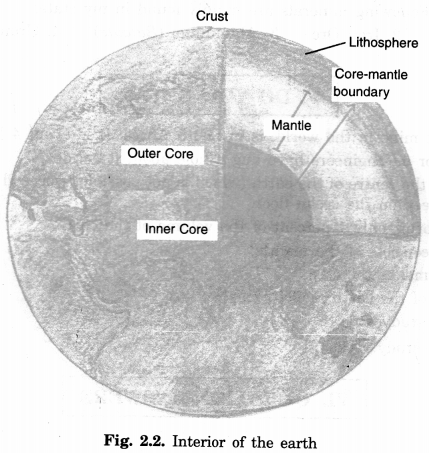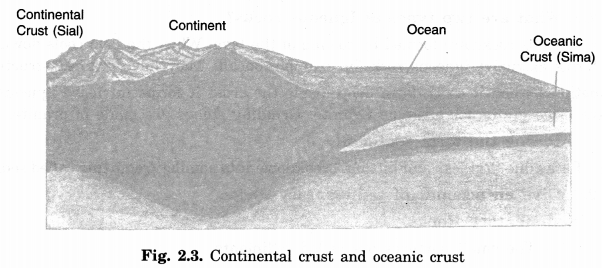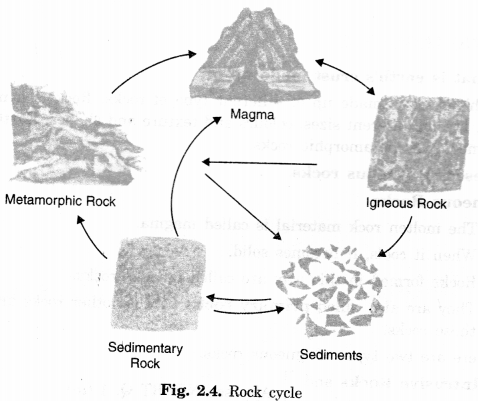Inside Our Earth Class 7 Extra Questions Social Science Geography Chapter 2
NCERT Extra Questions for Class 7 Social Science Geography Chapter 2 Inside Our Earth
Prelude
Question 1.
How is the earth a dynamic planet?
Answer:
- The earth is our homeland.
- It is a dynamic planet.
- It is constantly undergoing changes inside and outside.
Interior of the Earth
Question 1.
Have you ever wondered what lies in the interior of the earth? What is the earth made up of?
Ans.
- Yes.
- The interior has three major layers of rocks of different densities.
- The earth is made up of rocks.
Question 2.
Describe the interior of the earth.
Answer:
Interior of the Earth:
The earth is made up of several concentric layers with one inside another, just like an onion.
Crust:
- The uppermost layer on the earth’s surface is called the crust.
- It is the thinnest of all the layers.
- It is about 35 km, thick on the continental masses and only 5 km thick on the ocean floors.
- Main minerals constituent of the continental mass are silica and alumina.
- It is thus called sial (si – silica and al – alumina).

- The oceanic crust mainly consists of silica and magnesium.
- It is therefore called sima (si – silica and ma – magnesium).

Mantle
- Just beneath the crust is the mantle.
- It extends up to a depth of 2900 km below the crust.
Core
- The innermost layer is the core with a radius of about 3500 km.
- It is mainly made up of nickel and iron.
- Hence it is called nife (ni—nickel and fe—ferrous i.e., iron).
- The central core has very high temperature and pressure.
Rocks and Minerals
Question 1.
What is earth’s crust made up of?
Answer:
Earth’s crust is made up of different type of rocks. Rock is a natural mass of mineral matter. It is of different sizes, colours and texture and shapes. Earth is made up of sedimentary, igneous or metamorphic rocks.
Question 2.
Describe igneous rocks.
Ans.
Igneous Rocks
- The molten rock material is called magma.
- When it cools, it becomes solid.
- Rocks formed in this way are called igneous rocks.
- They are also called primary rocks because other rocks are formed out of these rocks.
There are two types of igneous rocks.
- Intrusive Rocks and
- Extrusive Rocks
Formation of Extrusive and Intrusive Rocks:
- Due to extreme heat in the interior of the earth, rocks are found in the form of molten material called magma.
- When magma comes out on the surface of the earth, it cools down and turns into solid rocks. Such rocks are termed as extrusive rocks.
Examples:
- Basalt.
- Deccan Trap is built of basalt.
When the molten magma cools down within the interior of the earth, it becomes solid to form intrusive rocks.
Examples:
- Granite
- Garbo
Question 3.
What is lava?
Answer:
Lava is the hot red magma coming out from the interior of the earth to the surface. It cools down and become solid.
Question 4.
What are two types of Igneous rocks?
Answer:
Igneous rocks are formed by cooling of the lava. When the lava cools down on the crust it forms extrusive igneous rock for example basalt. They have grained structure.
Sometimes when it cools down deep inside the crust it forms intrusive igneous rocks. They have large grains for example Granite. Grinding stones are made of granite.
Question 5.
Define the term sediment.
Answer:
Rocks due to cracks and hitting, breakdown into smaller fragments called sediments.
Question 6.
Give an account of sedimentary rocks.
Answer:
Sedimentary Rocks
The small particles are called sediments.
- These sediments are transported and deposited by wind, water etc. in low areas.
- These loose sediments are compressed and hardened to form layers of rocks.
- These layered rocks are called sedimentary rocks.
Examples:
- Sandstone.
- These rocks also contain fossils of plants, animals and other micro-organisms that once lived on them.

Question 7.
What are Fossils?
Answer:
Fossils:
The remains of dead plants and animals trapped in the layers of rocks are known as fossils.
Question 8.
How are metamorphic rocks formed?
Answer:
Igneous and Sedimentary rocks changes into metamorphic rocks under heat and pressure.
Metamorphic Rocks:
When under heat and pressure igneous rocks and sedimentary rocks change their form and more precious rocks are formed to be known as metamorphic rocks.
Examples:
- Granite into granite gneiss.
- Coal into slate.
- Slate into schist.
- Limestone into marble.
Limestone is changed into marble due to the following reasons:
- The overlying layers of rocks put pressure on the underlying rocks.
- From surface to interior of the earth, temperature and heat go on increasing.
- Due to pressure and heat, the original limestone changes into marble.g
Question 9.
What are the uses of rocks?
Answer:
Uses of Rocks:
- Hard rocks are used in making buildings and barrages.
- Houses and buildings are built of rocks (stones, slates, granite, marble).
- Stones are used in numerous games:
- Seven stones (phitthoo).
- Hop scotch (stapu, kit kit).
- Five stones (gitti).
- Rocks (stones and slates) are used in building bridges, embankments.
Question 10.
Briefly describe the ‘rock cycle’.
Answer:
One rock changes into another under certain conditions in a cyclic manner.
Molten magma cools down and solidify to form igneous rocks. These rocks are broken down due to pressure and climatic conditions into sediments.
These are transported and deposited to form sedimentary rocks. The igneous and sedimentary rocks under heat and pressure change into metamorphic rocks.
These metamorphic rocks under great heat and pressure melt down to form molten magma. This again cools down to form igneous rocks. This process of transformation of rocks is called ‘rock cycle’.
Question 11.
What are minerals? How are minerals important to us?
Answer:
Minerals:
- Rocks are made up of different minerals.
- Minerals are naturally occurring substances which have certain physical properties and definite chemical composition.
- Minerals are very important to us.
- Some are used as fuels.
Examples:
- Coal.
- Natural gas.
- Petroleum.
They are also used in industries as energy and raw material.
Examples:
- Iron.
- Aluminium.
- Gold.
- Uranium.
They are used in medicine, in fertilisers etc.
Objective Type Questions
Question 1.
Fill in the blanks with appropriate words:
1. Lava is the molten magma from ……………………… of the earth’s surface.
2. Like a ………………………, the earth is made up of ……………………… layers.
3. Crust is about ……………………… km on the continental mass and ……………………… km on the
ocean floor.
4. Mantle forms about ……………………… of the earth’s volume.
5. Core has a radius of about ……………………… km and has very high temperature and ………………………
6. Limestone under excessive heat and pressure changes into ………………………
Answer:
1. interior
2. onion, concentric
3. 35 and 5
4. 16%
5. 3500, pressure
6. marble
Question 2.
State whether the given statements are true or false:
1. Crust is the thickest of all the layers.
2. Core is the innermost layer of the earth.
3. Mantle extends up to the depth of 2900 km.
4. The loose sediments are hardened to form metamorphic rocks.
5. Deccan plateau is made up of basalt.
6. Fossils are remains of dead plants and animals.
Answer:
1. False
2. True
3. True
4. False
5. True
6. True
Question 3.
Match the contents of Column A with that of Column B.

Answer:
1. (d)
2. (e)
3. (f)
4. (d)
5. (b)
6. (c).
Multiple Choice Questions
Prelude
Question 1.
Where is the deepest mine in the world located?
(a) South America
(b) South Africa
(c) South India
(d) South Australia
Answer:
(b) South Africa
Question 2.
The depth of the deepest mine in South Africa is
(a) one km
(b) two km
(c) three km
(d) four km
Answer:
four km
Interior of the Earth
Question 1.
The upper most layer of the earth’s surface is called
(a) the crust
(b) the brust
(c) the roads
(d) the forest
Answer:
(c) the roads
Question 2.
What is the radius of the earth?
(a) 3671 km
(b) 7163 km
(c) 6371 km
(d) 1736 km
Answer:
(c) 6371 km
Rocks and Minerals
Question 1.
Any natural mass of mineral matter that makes up the earth’s crust is called a
(a) rock
(b) road
(c) sediment
(d) none of these
Answer:
(a) rock
Question 2.
The sediments are transported and deposited by
(a) wind
(b) water
(c) wind and water
(d) none of these
Answer:
(c) wind and water
Question 3.
The process of transformation of the rock from one form to another is known as
(a) road cycle
(b) food cycle
(c) rock cycle
(d) all of these
Answer:
rock cycle
Question 4.
Which rock is the molten magma made up of?
(a) Igneous
(b) Metamorphic
(c) Sedimentary
(d) None of these
Answer:
Igneous
Question 5.
What is the latin term of Igneous?
(a) Ignis
(b) Sedimentum
(c) Metamorphose
(d) None of these
Answer:
Ignis
Question 6.
Rocks which contain fossils are called
(a) metamorphic rocks
(b) igneous rocks
(c) core
(d) sedimentary rocks
Answer:
sedimentary rocks










